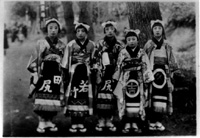|
Abraham
Ravett was born in Poland in 1947, raised in Israel
and emigrated to the U.S.A. in 1955. He holds a B.F.A.
and M.F.A. in Filmmaking and Photography and has been
an independent filmmaker for the past twenty years.
Mr. Ravett received grants for his work from The National
Endowment for the Arts, The Artists Foundation Inc,
Boston, MA., The Massachusetts Council on the Arts
and Humanities, The Japan Foundation, The Hoso Bunka
Foundation, the John Simon Guggenheim Memorial Foundation,
and the National Foundation for Jewish Culture. His
films have been screened internationally including
the Museum of Modern Art, Anthology Film Archives,
The Collective For Living Cinema, N.Y.C., Pacific
Film Archives, Berkeley, CA., S.F. Cinematheque, L.A.
Forum, Innis Film Society, Toronto, Canada, and Image
Forum, Tokyo, Japan. http://hampshire.edu/~arPF/
HORSE/KAPPA/HOUSE
33 min., b/w & color, sound, 16mm, 1995
Director:
Abraham Ravett
Iwate
Prefecture in northeastern Japan is the setting for
The Legends of Tono (Tono monogatari), a unique collection
of regional folk tales, gathered in the early 20th Century
by Yanagita Kunio. The tales manifest and explain invisible
forces and malevolent events which shape the psycho-cultural
dimensions of Japanese indigenous beliefs and folk faith.
 |
Inspired
by The Legends of Tono, HORSE/KAPPA/HOUSE, records
the surrounding landscape in a number of small villages
throughout Iwante Prefecture in order to create a cinematic
space which echoes by implication and association, the
external and unseen world in the environment. The film
embodies the idea so eloquently stated by noted historian,
Mr. Umehara Takeshi, that "all living things-animals
and plants, as well as mountains, rivers, and other
natural phenomena have spirits and that these spirits
are constantly moving back and forth between Heaven
and this world, forming the basis of the Japanese ethos."
The form of the film was shaped in the editing and post-production
process, as Ravett sought to embody the ephemeral into
material form. He utilized a combination of time lapse
cinematography, animation, optical printing and intertitles
to provide a context for a broader understanding of
the legends. The audio track- a conbination of indigenous
sounds, field recordings of religious ceremonies, plus
Komori Uta (lullabies) chanted by Aba Yae, a renowned
singer and local farmer, adds a haunting, emotionally
charged layer of meaning to the visual tapestry. For
example, Dendera Field, seen today as a lovely pastoral
landscape, was historically the site where children
abandoned elderly parents who were seen as no longer
productive. Framed by the sounds of birds chirping,
the long, timelapse view of Dendrea Field is presented
as a space of loss, memory, and collective history.
Funded
by the Hoso Bunka Foundation, The Japan Foundation,
and a Filmmaking Fellowship from the John Simon Guggenheim
Memorial Foundation.
|
Forgefeel
12 min., color, sound, 16mm, 1997
Director:
Abraham Ravett
The
landscape is a rendered playground at a San Francisco
Public School. "Forgefeel," is the Yiddish word
for premonition.
|
Half
Sister 22 min., color, sound, 16mm, 1985
Director:
Abraham Ravett
A
recently discovered photograph of my half sister
who was killed in the German concentration camp
of Auschwitz, inspires the imagination to concieve
a life that would have been.
|
|
